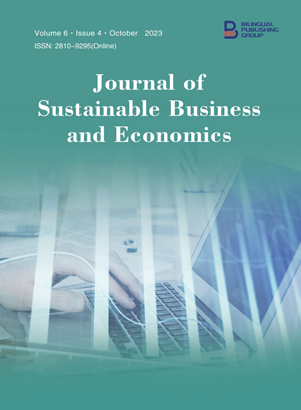-
275
-
190
-
176
-
158
-
133
The Belt and Road Initiative's (BRI) Impact on International Trade of SAARC Countries
DOI:
https://doi.org/10.30564/jsbe.v7i1.6141Abstract
The impact of the Belt and Road Initiative (BRI) on foreign commerce in the nations that make up the South Asian Association for Regional Cooperation (SAARC) is compared in this study. With data taken from the World Integrated Trade Solution (WITS) for two different time periods (2008–2012 and 2014–2018), the study assesses changes in imports, exports, trade balances, and foreign direct investment (FDI) in Afghanistan, Bangladesh, Bhutan, India, Maldives, Nepal, Pakistan, and Sri Lanka. Different patterns in trade dynamics are revealed by the findings. Bangladesh had notable improvements in trade over the 2014–2018 period, whereas Afghanistan’s development was less than anticipated. Bhutan’s trade development was encouraged and in line with the goals of the Belt and Road Initiative. India demonstrated trade endurance by continuing to develop steadily. Positive developments were demonstrated by the Maldives, Nepal, Pakistan, and Sri Lanka, confirming the BRI’s contribution to the growth of commerce. There have been improvements in the trade balances of Pakistan, Afghanistan, and the Maldives. Following the BRI, the FDI landscape steadied, with increases in FDI observed in Pakistan, Afghanistan, and the Maldives. With an emphasis on the significance of taking into account the particular context of every nation and the dynamic nature of international commerce, this research offers a comprehensive assessment of the effects of the Belt and Road Initiative. The results provide insightful information to help stakeholders, scholars, and policymakers navigate the intricate web of international commerce in the SAARC area.
Keywords:
Belt and Road Initiative; SAARC countries; International trade; Comparative analysisReferences
[1] China Belt and Road Initiative (BRI) Investment Report 2021 [Internet]. Green Finance & Development Center. Available from: https://greenfdc.org/wp-content/uploads/2022/02/Nedopil-2022_BRI-Investment-Report-2021.pdf
[2] Ohashi, H., 2018. The Belt and Road Initiative (BRI) in the context of China's opening-up policy. Journal of Contemporary East Asia Studies. 7(2), 85–103. DOI: https://doi.org/10.1080/24761028.2018.1564615
[3] Rasool, A., 2022. Belt and Road Initiative’s regional impact: Lessons from South Asia. The Journal of Indian and Asian Studies. 3(1), 2250003. DOI: https://doi.org/10.1142/S2717541322500036
[4] Moustaira, E., 2023. Caribbean Community (CARICOM)-Culture (Comunidade Caribenha (CARICOM)-Cultura). Revista Electrónica de Direito-RED.
[5] The Eurasian Economic Union and China—A Fire Bowl of Interests [Internet]. Università Ca' Foscari Venezia. Available from: http://hdl.handle.net/10579/16114
[6] Majid, D.A., 2020. SAARC prospects and challenges. South Asian Studies. 33(1).
[7] Chakma, B., 2020. SAARC after 1992: Disagreements and differences. South Asian regionalism. Bristol University Press: Bristol. pp. 99–120. DOI: https://doi.org/10.51952/9781529205169.ch005
[8] Thammavong, S., 2020. China's Belt and Road Initiative: Perspectives from India [Ph.D. thesis]. Auckland: Auckland University of Technology.
[9] Winter, T., 2021. Geocultural power: China's belt and road initiative. Geopolitics. 26(5), 1376–1399. DOI: https://doi.org/10.1080/14650045.2020.1718656
[10] Garlick, J., 2019. The impact of China's belt and road initiative: From Asia to Europe. Routledge: London.
[11] Magu, S.M., 2023. Africa’s RECS—Promise and Peril, pandemic slips and possible futures. Towards Pan-Africanism: Africa’s Cooperation through Regional Economic Communities (RECs), Ubuntu and Communitarianism. Palgrave Macmillan: Singapore. pp. 299–332. DOI: https://doi.org/10.1007/978-981-19-8944-5_12
[12] Defraigne, J.C., 2021. The Eurasian Economic Union and the challenge of the BRI: A comparison of their respective impacts on economic development and Russia's regional leadership. Eurasian Geography and Economics. 62(5–6), 659–698. DOI: https://doi.org/10.1080/15387216.2021.1939086
[13] Bhattarai, G., 2022. From survival to sustenance. Nepal between China and India: Difficulty of being neutral. Palgrave Macmillan: Cham. pp. 105–145. DOI: https://doi.org/10.1007/978-3-030-99974-2_4
[14] van der Zwan, G.I.H., 2023. Chinese linkage and leverage under the Belt and Road Initiative (BRI) in Asia. China and world politics in transition: How China transforms the world political order. Springer: Cham. pp. 137–157. DOI: https://doi.org/10.1007/978-3-031-27358-2_8
[15] Gong, X., 2019. The Belt & Road Initiative and China’s influence in Southeast Asia. The Pacific Review. 32(4), 635–665. DOI: https://doi.org/10.1080/09512748.2018.1513950
[16] Chaudhry, T., Jamil, N., Chaudhry, A., 2017. Pakistan’s experience with the Pakistan-China FTA: Lessons for CPEC. The Lahore Journal of Economics. 22, 1–24.
[17] Gholizadeh, A., Madani, S., Saneinia, S., 2020. A geoeconomic and geopolitical review of Gwadar Port on belt and road initiative. Maritime Business Review. 5(4), 335–349. DOI: https://doi.org/10.1108/MABR-11-2019-0051
[18] Mahbub, S., 2021. Impact of Belt and Road Initiative (BRI) on China and South Asia trade integration. International Journal of Social Science And Human Research. 4(1), 109–112. DOI: https://doi.org/10.47191/ijsshr/v4-i1-16
[19] Wignaraja, G., Panditaratne, D., Kannangara, P., et al., 2020. Chinese investment and the BRI in Sri Lanka. Chatham House: London.
[20] Hussain, E., Rao, M.F., 2020. China-Pakistan economic cooperation: The case of special economic zones (SEZs). Fudan Journal of the Humanities and Social Sciences. 13(4), 453–472. DOI: https://doi.org/10.1007/s40647-020-00292-5
[21] Magu, S.M., 2023. Arab Maghreb Union (AMU): (In or Mostly) out of Africa and tumultuous inertia. Towards Pan-Africanism: Africa’s Cooperation through Regional Economic Communities (RECs), Ubuntu and Communitarianism. Springer Nature Singapore: Singapore. pp. 269–297. DOI: https://doi.org/10.1007/978-981-19-8944-5_11
[22] China’s Influence in South Asia: Vulnerabilities and Resilience in Four Countries [Internet]. Available from: https://carnegieendowment.org/files/202110-Pal_SouthAsiaChina_final1.pdf
[23] Cui, L., Song, M., 2019. Economic evaluation of the Belt and Road Initiative from an unimpeded trade perspective. International Journal of Logistics Research and Applications. 22(1), 25–46. DOI: https://doi.org/10.1080/13675567.2018.1492532
[24] Chand, H.P., 2020. Critical issues related to connectivity in South Asia. Journal of International Affairs. 3(1), 68–83. DOI: https://doi.org/10.3126/joia.v3i1.29084
Downloads
How to Cite
Issue
Article Type
License
Copyright © 2024 Naveed Sultan, Chaojun Yang, Waheed Sultan

This is an open access article under the Creative Commons Attribution 4.0 International License.




 Naveed Sultan
Naveed Sultan

